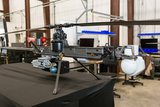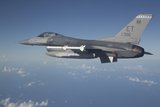Shifting demand for Strategic Airlift Capability drives base expansion
The SAC fleet consists of three C-17 aircraft. (Photo: NATO)
The Strategic Airlift Capability (SAC), comprised of 12 member nations (ten NATO allies and two partners), is building a permanent, combined aerial port facility at the Hungarian Pápa Air Base that will include a 3,200 sq m storage space, airdrop and cargo halls as well as a 33m parachute drying tower.
The building will be jointly funded by the US, Sweden, the Netherlands, Norway, Poland, Finland, Estonia, Lithuania, Bulgaria, Hungary, Romania and Slovenia. It will replace a temporary smaller structure, which proved to be a significant impediment for a military transport initiative such as the SAC.
The €10 million-plus structure
Already have an account? Log in
Want to keep reading this article?
More from Air Warfare
-
![Anduril UK and GKN Aerospace collaborate on British Army ACP bid]()
Anduril UK and GKN Aerospace collaborate on British Army ACP bid
The pair will submit their demonstrator concept for Project Nyx, a development project for the British Army’s Land Autonomous Collaborative Platform.
-
![US Army command’s Picatinny CLIK common lethal drone interface makes progress]()
US Army command’s Picatinny CLIK common lethal drone interface makes progress
The Picatinny Common Lethality Integration Kit is designed to overcome the issue of unique integration methods between lethal payloads and drones as well as avoiding problematic acquisition conditions created by vendor lock.
-
![Australia invests extra A$1.4 billion in MQ-28A Ghost Bat after successful missile fire test]()
Australia invests extra A$1.4 billion in MQ-28A Ghost Bat after successful missile fire test
The investment includes new contracts for six MQ-28A Ghost Bat aircraft, as well as provisional funds to invest in the development of a Block 3 prototype.
-
![US approves potential $4.7 billion missile and air defence system sales to Denmark and Italy]()
US approves potential $4.7 billion missile and air defence system sales to Denmark and Italy
Italy could field the JASSM-ER for its combat aircraft including the F-35, while Denmark has been approved for AMRAAM and an Integrated Battle Command system procurement.
-
![Northrop Grumman to fly new Project Talon CCA by late 2026]()
Northrop Grumman to fly new Project Talon CCA by late 2026
The newly unveiled collaborative combat aircraft looks to strike a balance between capability and cost-effectiveness, according to the company.
-
![MBDA and Lockheed move closer to F-35A Meteor flight tests]()
MBDA and Lockheed move closer to F-35A Meteor flight tests
Following the completion of successful ground tests, one more exercise remains before flight testing can begin.

























